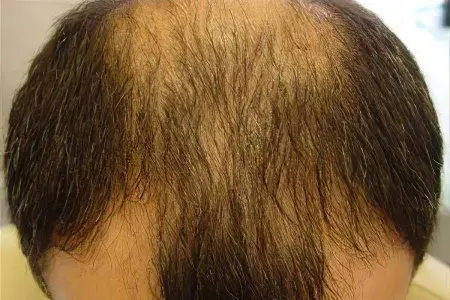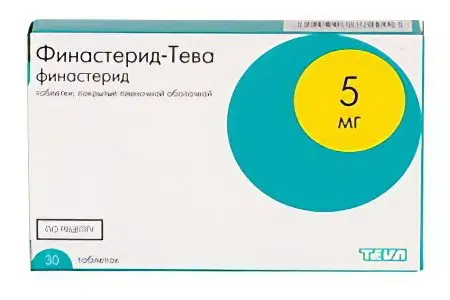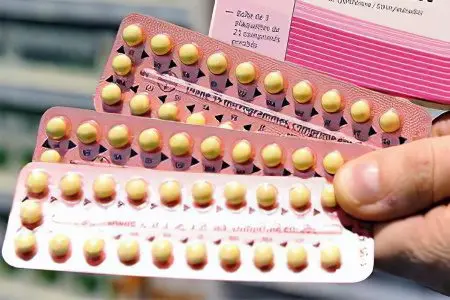Male androgenetic alopecia
Hair loss as a result of age-related changes in the body of a man is called male androgenetic alopecia. This process depends on the production of hormones – androgens. It is this form of baldness that occurs most often in males, in connection with which trichologists receive many complaints like this one:
«Good afternoon. At the age of 38, I noticed that I began to lose my hair. The area of baldness is gradually increasing and is now very noticeable, especially in the forehead area. The process does not stop there, now the top of the head has begun to thin.
Dad had the same problem, he also started losing hair around that age and is now practically bald. This, of course, is not very critical for me, however, if there is an opportunity to stop baldness, then I would like to use it. I saw a lot of advertisements for various products, I would like to know if anything really works or is it a waste of money?
The picture of androgenetic alopecia, as a rule, is characteristic of all men. A pattern familiar to everyone is formed on the head – the absence of hair on the forehead and crown, the preservation of the hairline on the sides. Because of patterned alopecia, androgenetic alopecia is sometimes also called pattern alopecia. This term comes from the English word pattern, which means “pattern”.
Causes of androgenetic alopecia in men

The work of androgens has a direct impact on all life processes. The main representative of this group of sex hormones is testosterone. It is he who gives the male skeleton characteristic masculine features, is responsible for increasing muscle and bone mass and increased hair growth.
However, with age, androgens begin to have an inhibitory rather than stimulating effect on the growth of hair that is located directly on the head. So, having got into the basal cells of the hair located on the forehead and crown, testosterone is transformed into dihydrotestosterone. Changes occur under the action of the enzyme 5-alpha-reductase type 2.
Dihydrotestosterone helps to slow down the work of hair follicles as a man grows older. As a result, the hair becomes thinner, breaks faster, loses color. Their structure begins to resemble the structure of the hair covering the body, as a result – the head of a man loses hair. Moreover, all these changes occur with a normal level of testosterone in the blood.
Cause of head baldness in men. Zonal alopecia with a predominant localization of hair loss in the crown region is explained by the difference in the biochemical properties of the scalp in different places. The skin that covers the back of the head and temples contains aromatase at a higher concentration than the skin that covers the forehead and parietal zone. This enzyme promotes the transformation of testosterone into estrone and estradiol. Their action is opposite to that of dihydrotestosterone. They do not slow down, but provoke the work of the follicles, so there is more hair on the sides of the head.
Hereditary cause of androgenetic alopecia. The conducted research allowed to establish the fact that a man prone to baldness, this tendency can be transmitted through the hereditary line. If the father suffered from androgenetic alopecia, then the risk of developing this condition in his son is quite high. Scientists believe that in such men the number of receptors located in the roots of the hair, which are susceptible to such a hormone as dihydrotestosterone, is much greater than in those men whose fathers did not suffer from baldness. In addition, the fact of excessive activity of the enzyme responsible for the production of a hormone that leads to hair loss cannot be ruled out.
Early male pattern baldness. It is an undeniable fact that a certain part of men lose their hair before the rest. There is an assumption that the age at which the process of alopecia manifests itself is genetically determined. In the absence of therapy, once the process of alopecia has begun, it will progress.
According to statistics, approximately 16% of men begin to lose hair before the age of 30. Upon reaching the age of 50, a pronounced degree of alopecia is observed in 50% of the male population. Almost 80% of men lose their hair by the age of 70.
Treatment of androgenic alopecia in men
In order to stop the process of alopecia, as well as restore the already lost part of the hair, modern medicine offers two types of medicines for use:
Minoxidil, which comes in the form of a foam or lotion. The tool is to be applied to the scalp, subjected to alopecia;
Finasteride tablets.
Treatment of androgenetic alopecia with Minoxidil
Initially, the drug was developed for the treatment of hypertension. It has not yet been possible to accurately determine the mechanism of its effect on hair follicles.
It is necessary to use the product twice a day: in the morning and in the evening. Foam or lotion is applied to the scalp in those places that are prone to alopecia.
After the start of therapy, patients often note an increase in hair loss. This process is explained by the fact that the drug prepares the hair follicles for renewal. After the old hair is removed, the follicles begin to produce substances responsible for the growth of new hair. The initial loss will be completed months (sometimes weeks) after starting Minoxidil.
The result of the therapy can be evaluated for the first time in the period from 4 months to six months. A pronounced effect will be noticeable after an annual course of treatment.
The percentage of restoration of hair density ranges from 14,5% to 248,5%. These indicators are a comparative characteristic in comparison with the density of the hairline before the start of therapy. Alopecia as a result of treatment with Minoxidil usually stops.
A stable result is more often achieved by those men who have resorted to treatment under the age of 40 years. It is important that the alopecia process manifest itself no later than 10 years ago. In addition, the chance for a complete restoration of the hairline is higher in those men whose alopecia area does not exceed 100 mm in diameter.
It is generally accepted that even a long course of therapy with Minoxidil is safe. Extremely rarely carried out treatment can lead to hypotension, tachycardia and water retention in the body. Similar phenomena are observed in people with hypersensitivity to this remedy. Sometimes Minoxidil causes accelerated facial hair growth, but this problem for the male is not significant.
Treatment of androgenetic alopecia with Finasteride

The principle of operation of the drug is based on the inhibition of the functioning of the enzyme 5a-reductase. It is this enzyme that causes the transformation of testosterone into dihydrotestosterone, which provokes alopecia. In addition to the treatment of baldness, Finasteride is used in the treatment of prostate adenoma. However, this requires an increase in the dose of the drug.
Finasteride is easier to use than Minoxidil. It is enough to take the drug orally once a day.
The effect of the ongoing treatment can be detected after a period of 4 months to six months. In a year, the effect will be even more noticeable, and patients receive maximum results two years after the start of therapy.
Studies indicate that Finasteride is more effective in relieving male alopecia than Minoxidil. So, 99% of men who take the drug on a regular basis, stop suffering from hair loss.
Only 2% of patients succeed in restoring hair in already existing areas of alopecia to a large extent, their slight growth in areas of baldness is observed in 30%, and the return of hair to an average degree occurs in 16% of men.
The maximum effect will be obtained from Finasteride if the therapy was started in a timely manner, that is, until the bald head has reached a significant size.
If the result was achieved, then a constant intake of the drug will be required to maintain it. If the therapeutic course is stopped, then the restored hair will fall out after a maximum of a year.
As for complications, as a rule, they do not occur even against the background of long-term use of the drug.
Partial loss of sexual desire and erectile dysfunction, as side effects of taking the drug, are extremely rare. If such complications arise, then the treatment is stopped.
Combination of Finasteride and Minoxidil for the treatment of alopecia in men. Conducted studies indicate that it is possible to combine these two agents for the treatment of alopecia. Moreover, the effect will be enhanced if there is a simultaneous intake of Finasteride orally and Minoxidil externally.
Switching from Minoxidil to Finasteride. When a man needs to make the transition from Minoxidil to taking Finasteride tablets, then for six months he will have to use these two drugs in parallel. After 6 months, one of the drugs is abandoned, while the other continues to be used.
Alternative therapy for androgenetic alopecia in men
It is important to understand that there are no other effective methods of treating pathology. There are other agents that have an effect similar to the mechanism of Finasteride and Minoxidil. An example is dutasteride. However, it is not possible to fully replace any of the main treatments for alopecia at this point in time.
Another treatment for baldness is hair transplantation. After that, patients need to take either Minoxidil or Finasteride, as the transplanted hair will otherwise fall out under the influence of hormones and enzymes. Taking medications will allow you to achieve a lasting cosmetic effect from the operation. Therefore, hair transplantation should be considered as an auxiliary method of therapy against the background of drug treatment. It allows you to restore hairline in those places where it was not possible to resume their growth with the help of conservative treatment.
The sequence of treatment for patients with androgenetic alopecia does not depend on the degree of baldness:
Despite the severity of alopecia, therapy should begin with Finasteride or Minoxidil. It is possible to combine these means;
If the patient has severe seborrhea, then it is advisable to conduct parallel treatment of this disease of the scalp;
A year later, the patient should notice a stop of hair loss and their partial recovery;
If the initial degree of alopecia was mild, then the patient can stop the treatment course at his own discretion;
If the initial degree of alopecia was very pronounced, then it will not be possible to restore the hairline in full with the help of medication alone, and a hair transplant will be required. After its implementation, therapy should be continued.
Androgenetic alopecia in women

It is not uncommon to find complaints of hair loss from women. Here is one of the requests: “Good afternoon, for several years now I have noticed that hair has begun to fall out on my head, mainly in the crown area. The parting has become wider, skin is visible through the hair. At the same time, hair grows on the sides and in the forehead area, as before. Shampoos did not help, so I had to go to the doctor. He told me that I had androgenetic alopecia. But I thought that only men go bald, and this problem does not concern women. Rather, it does, but their hair falls out due to medication or illness. What should I do now, how to return my hair and beauty?
In fact, androgenetic alopecia is a problem for both sexes. Moreover, in the fair sex, this disease is not as rare as it might seem. Statistics indicate that up to 12% of women who have reached the age of 30 begin to lose hair.
The older a woman becomes, the brighter the main signs of alopecia, and by the age of 50, hair for this type of baldness has already lost 25%. As for the age of 70, 40% of women at this age will be subject to hair loss to one degree or another. Just like in men, female pattern baldness forms a certain pattern on the head.
The causes of hair loss in the type of androgenetic alopecia in women are not the same as in men:
Pathology of the thyroid gland;
Diffuse forms of alopecia;
Chronic telogen baldness;
Anemia, etc.
Causes of androgenetic alopecia in women
Recent studies have suggested that androgenetic alopecia in women occurs against the background of normal blood levels of male sex hormones – androgens. However, the relationship between the onset of baldness and the hormonal status of a woman still exists. So, with an increase in the concentration of hormones, as well as with too much sensitivity to them, a process can begin that resembles androgenic alopecia.
In addition to the fact that a woman begins to lose her hair, she may note other symptoms, including:
Menstrual irregularities;
The appearance of facial hair, increased hair growth on the body;
Inability to conceive a child;
Pimples and acne on the skin;
Polycystic ovary syndrome.
When none of these symptoms accompanies the process of hair loss, then androgenetic alopecia is most likely a misdiagnosis.
Treatment of androgenetic alopecia in women
You can stop hair loss with Minoxidil. This is the only remedy that has proven effectiveness and can really help a woman cope with the pathological process.
Most often, for the treatment of baldness, a lotion containing Minoxidil is used, the concentration of which does not exceed 2%.
The product is rubbed into the scalp, precisely in those areas that have undergone alopecia. You will need to apply lotion in the morning and evening hours.
In the initial stages of treatment, the drug causes increased hair loss. When the shedding of old hair stops (this process can take several months), the follicles will begin to reproduce new hair.
Six months later, the woman will be able to evaluate the first results of the therapy. The full effect will be noticeable only after a year.
Studies have been conducted using placebo and Minoxidil. It was found that a year later the drug managed to stop androgenetic alopecia in 29% of the women participating in the experiment.
A side effect of using the drug is increased facial hair growth. The higher the concentration of the active substance, the higher the risk of developing this side effect. So, when using a 5% solution, facial hair appeared in 14% of women, and when using a 2% solution, this problem arose only in 6% of patients. When the treatment stops, then the hair stops growing. Complete inhibition of their growth is observed a few months after the abolition of Minoxidil.
Alternative Therapy for Androgenetic Alopecia in Women

There is no information that there are any other effective drugs that allow a woman to get rid of hair loss. Thus, a study on the use of Finasteride by women with androgenetic alopecia indicated that the desired effect cannot be achieved. Therefore, the remedy is recognized as effective only for the treatment of men with androgenetic alopecia.
There are some data indicating the achievement of a result when Finasteride is taken in high concentrations. To stop hair loss, a woman may need to take up to 5 mg of the drug per day. However, there are no specific recommendations.
If a woman has an increased content of male sex hormones, then contraceptives with their antiandrogenic components can help stop baldness. For example, such drugs include Spironolactone, Chlormadinone, Cyproterone Acetate, Flutamide, Drospirenone. However, if the level of male hormones in the woman’s blood remains at a normal level, then there will be no effect from taking these drugs. The same applies to ordinary hormonal contraceptives with estrogen and progesterone.
As for hair transplantation, this method, just like for men, is auxiliary. It will make it possible to eliminate a cosmetic defect, but after the procedure, Minoxidil will have to be used so that the result is not lost. Therefore, a transplant is done in the case when conservative treatment is powerless.
The process of getting rid of a woman from androgenetic alopecia proceeds as follows:
Appeal to a trichologist to establish the true cause of hair loss;
Initiation of therapy with Minoxidil upon confirmation of the diagnosis of “androgenetic alopecia”;
Getting rid of the scalp from seborrhea, if necessary;
Stopping the pathological process after a year from the start of therapy;
At the initial stage of baldness, women are most often satisfied with the result. They may continue to use Minoxidil for as long as they feel necessary;
If alopecia is strongly pronounced, then most often it is not possible to achieve complete restoration of the hairline. In this case, after a year of therapy, it is necessary to perform a transplant, and then continue conservative treatment.
Therapies with unproven efficacy
In order to cope with hair loss, women resort to various methods, including:
Applying various vegetable oils to the hair;
Taking vitamins and amino acids, even with a normal diet;
The use of preparations based on bergamot, green tea, algae, caffeine, hibiscus, Aloe Vera, melatonin, sabal palm (extract);
The use of Chinese medicine;
Laser and electromagnetic treatment;
The use of retinoids, Botox;
The use of funds to stimulate blood circulation at the location of the hair follicles;
Mesotherapy;
Capsules with Aminexil;
Shampoos with ketoconazole and zinc in the absence of dandruff;
Topical agents with corticosteroids included in their composition;
Means based on Fluridil, Alfatraradiol, Fulvestrant.
Despite this variety of agents, none has evidence of effectiveness in the treatment of androgenetic alopecia in both women and men.
Author of the article: Herman Olga Leonidovna, trichologist, specially for the site ayzdorov.ru









